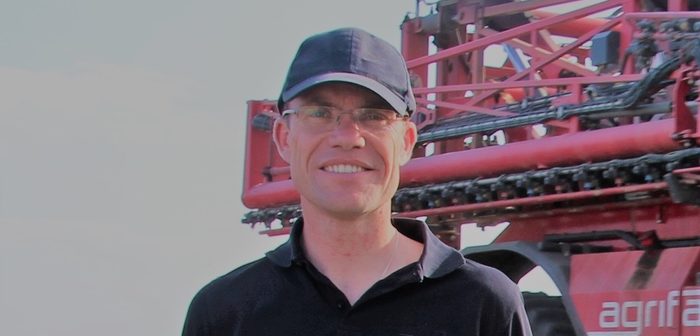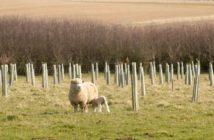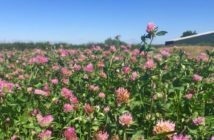- There are limited options for the control of weeds in pulses
- Bentazone is a post-emergence herbicide for use in peas, beans, potatoes and alliums
- It is vital that users make themselves aware of the stewardship actions needed to prevent it appearing in water
- Best practise must become standard practise in order to protect this chemistryUsers of bentazone, as in a number of herbicides such as Basagran SG, must collectively take up the mantle of BASF’s Water Stewardship campaign or they could lose this useful post-emergence herbicide in the future.
Bentazone is a post-emergence broad-leaved weed herbicide used in spring and winter field beans, broad beans, dwarf French beans, navy and runner beans, peas, linseed, narcissi and potatoes. It also has EAMUs for use on salad onions, leeks garlic, bulb onions, shallots, ornamental plant production, hops, chives and herbs.
Bentazone has been identified from official monitoring as the herbicide most frequent to exceed the Drinking Water standard in groundwater and is increasingly found in surface water. This is also the case in Europe. All formulations of bentazone have the potential to be found in water and Stewardship Guidance applies to them all. Authorisation for bentazone products in Europe could be restricted or lost unless care is taken to protect water.
Bentazone is extremely soluble and can be highly mobile through soil. Even in the drier months, this combination results in bentazone appearing in water. Leaching to groundwater is more likely on vulnerable soils. Surface water may be reached via drain flow, surface run off or spray drift.
Growers should know if their fields are on vulnerable soils and the treat following these Stewardship Guidance –
Responsible use of bentazone High Risk Areas * All other areas Soils Shallow,** stony soils*** over chalk or limestone** Do not Use Avoid use Shallow** soils over sand or gritstone Do not Use Avoid use With shallow groundwater Do not Use Avoid use With very low organic carbon Do not Use Avoid use Other soils OK to use OK to use Timing Spring and summer OK after 1st April OK to use Autumn and winter Do not use Do not use Rate All soils Do not use >1000g a.i./ha Avoid using >1000g a.i./ha * Drinking Water Groundwater Safeguard Zones for bentazone or nitrate, Groundwater Source Protection Zones 1+2 (see Gov.uk “check for zones” and for ground water source protection zones 1+2 See Natural England “Magic Map“.)
**Shallow, stony soils have a low maximum ploughing depth (<30-35 cm).
***High stone content (>1 cm) in top soil and at the soil surface (>10% of surface area). These soilsalso tend to have a High pH (>7).
Soils with shallow groundwater are those where ground water occurs <1 m below soil surface for at least part of the year. These soils are generally located in river valleys and lowlands. For some of these soils, groundwater level may lead to lmited oportunities to use heavy machinery.
Protect surface waters from leaching by following Bentazone Stewardship Guidance:
SURFACE WATER Rainfall Do not apply if heavy rainfall is likely within 48 hours Drain flow Avoid application when drains are flowing or likely to flow within 7 days Run-off, Spray drift Use a minimum 6m grass buffer strip Rate Do not use more than 1000g a.i./ha/year * Drinking Water Groundwater Safeguard Zones for bentazone or nitrate. Groundwater Source Protection Zones 1 + 2 (see Environment Agency website “What’s In Your Back Yard (WIYBY).” - The maximum rate of Basagran SG has been reduced to 1.1 kg/ha delivering 957g a.i./ha. Other products may permit a higher rate of use: rate of use is a significant factor in subsequent detects in water.
- Use bentazone as late as possible to reduce leaching probability, but not if soils are cracked or saturated
- Do not apply in autumn/winter
All formulations of bentazone have the potential to be found in water and the Stewardship Guidance applies to them all. To prevent or minimise movement to water all applications need to be as ‘best practise.’
Avoid point source pollution (farmyard runoff, spillages)
Do not exceed 1000 gms a.i//ha /year
Know if you have vulnerable soils and treat accordingly
Use 6 metre buffer zones against water courses
Give consideration for rain being forecast
Use the bentazone Water Protection sheet, obtained from BASF
https://voluntaryinitiative.org.uk/media/2181/bentazonemarch2017final.pdf
For more information on Bentazone Stewardship Guidance visit:
https://www.agricentre.basf.co.uk/en/Sustainability/Water-Stewardship/Bentazone-Stewardship/ or https://voluntaryinitiative.org.uk/schemes/stewardship/bentazone-water-stewardship/
Bentazone Stewardship – be aware!
Share this story:




